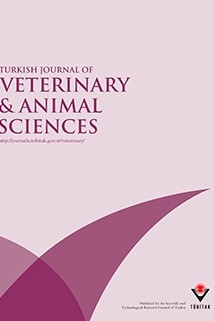
Turkish Journal of Veterinary and Animal Sciences
Yazarlar: Nadi ÇOLAKOĞLU
Konular:-
Anahtar Kelimeler:Sheep,Akkaraman,Malya,Growth,Fertility,Viability,Wool characteristics.
Özet: Summary : This research was carried out to compare the fertility traits, greasy fleece weight and wool characteristics in breeding ewes; and the growth and survival rates of lambs in Ankaraman and Malya breeds. The data was obtained for fertility traits from 5581 Malya and 9707 Akkaraman ewes, for growth rates from 100 lambs in each breed, for greasy fleece weights from 100 ewes in each breed and for wool characteristics from 32 Malya and 28 Akkaraman ewes. Fertility traits such as lambing percentage, twinning rate, litter size and number of lambs weaned per hundred ewes lambing between 1992 and 1995 were found to be 87.2 - 90.6 %; 29.4 - 44.6 %; 1.29 - 1.44 and 112.1 - 121.7 for the Malya breed; 87.2 - 90.5 %; 29.5 - 43.1 % ; 1.29 - 1.44 and 113.3 - 125.8 for the Akkaraman breed, respectively. Least squares weights at birth and on the 105th, 150th, 180th, 210th, 240th and 360th day were found to be 4.591, 31.803, 37.200, 35.965, 37.961, 40.548 and 57.158 kg for Malya lambs; 4.915, 33.667, 38.878, 38.685, 41.607, 44.110 and 60.264 kg for Akkaraman lambs, respectively. Akkaraman lambs were for greater weight than Malya lambs in all ages; and differences between breeds at all different growth periods were significant. Effects of the lambs' sex and type of birth on the lambs' weights at different ages were significant. Of the lambs born alive at different years, 91.4 - 96.2 % and 96.1 - 97.6 % survived to the 105th day (weaning weight) in Malya and Akkaraman breeds, respectively. Greasy fleece weights were found to be 2.364 kg and 2.464 kg in Malya and Akkaraman breeding ewes. The average means for fiber length, fiber diameter, crimps in 2.54 cm, percentage of medullated fiber and wool efficiency were 10.27 cm, 24.61µ, 8.75, 0.00 % and 48.34 % in Malya breed, 14.15 cm, 27.96 µ, 4.01, 0.25 % and 51.41 % in Akkaraman breed, respectively. Differences between breeds for fiber length, fiber diameter and crimps were significant. Income from sheep breeding generally depends on lamb production. Although the growth rate of Akkaraman lambs is greater than Malya lambs, edible lamb production from the Malya breed is higher than the Akkaraman breed because Akkaraman are fat-tailed. Therefore, bearing in mind that the adaptation capability of the Malya breed to Central Anatolian conditions is very high like the Akkaraman breed, keeping the Malya breed is more suitable than the Akkaraman breed.
Dergi editörleri editör girişini kullanarak sisteme giriş yapabilirler. Editör girişi için tıklayınız.